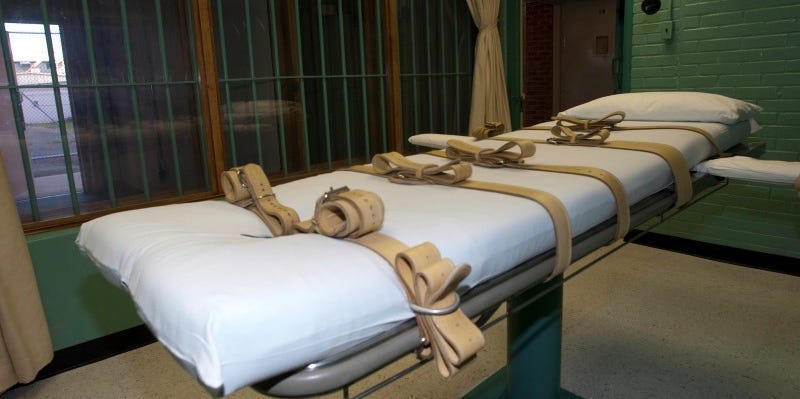- A judge ruled that the controversial three-drug lethal injection method is constitutional in Oklahoma.
- The lawsuit was filed by 35 inmates in 2014 who said it violated the Eighth and Fourteenth amendments.
- The inmates argued it could "produce severe pain, needless suffering, and a lingering death."
A federal judge ruled Monday that the highly controversial three-drug lethal injection protocol used to execute death row inmates in Oklahoma is constitutional.
The lethal injection protocol has remained the dominant method of carrying out capital punishment in the US since its rise in 1977, but a lawsuit filed by death row prisoners in the state highlighted concerns over substantial suffering prompted by the method.
Thirty-five death row prisoners filed a suit in the United States District Court for the Western District of Oklahoma in June 2014, arguing that the deadly three-drug cocktail violated the Eighth and Fourteenth amendments.
The inmates cited the botched execution of Clayton Lockett — who "writhed and groaned" on his death bed for nearly 45 minutes — in April 2014.
However, Judge Stephen Friot said in a 45-page document that "the plaintiff inmates have fallen well short of clearing the bar set by the Supreme Court."
"The district court's decision ignores the overwhelming evidence presented at trial that Oklahoma's execution protocol, both as written and as implemented, creates an unacceptable risk that prisoners will experience severe pain and suffering," Jennifer Moreno, an attorney for the inmates, told Insider in a statement.
"We are assessing our options for an appeal," she added.
Oklahoma's three-drug lethal injection protocol initially contained an anesthetic such as sodium thiopental or pentobarbital — both are barbiturates which makes them capable of inducing coma. Next, the inmate is injected with a paralytic agent before administering the final drug, potassium chloride, which stops the heart, according to Death Penalty Information Center.
But after drug manufacturers caught on that the use of their drugs to execute prisoners was causing a drug shortage, executioners began relying on an alternative anesthetic drug: midazolam.
Midazolam is a sedative used to calm anxiety and has not been cleared by the Federal Drug Administration for use as an anesthetic, according to NPR. Its efficacy is still debated by experts.
"The Court's ruling is definitive: The plaintiffs in this case 'have fallen well short' of making their case, and midazolam, as the State has repeatedly shown, 'can be relied upon … to render the inmate insensate to pain,'" Oklahoma Attorney General John O'Connor said in a statement to Insider. "My team is reviewing the US District Court's order further and will make a decision regarding when to request execution dates from the Oklahoma Court of Criminal Appeals."
After a nearly six-year moratorium, the state pushed forward on October 28, 2021, with executing inmates — including one who had a mental illness and another who had an intellectual disability — before the trial began on February 28, 2022. Several inmates have since been executed and one — Julius Jones — was terminated from the lawsuit, leaving 28 names on the suit.
There are at least 41 inmates currently on Oklahoma's death row.
Robert Dunham, executive director of the nonpartisan non-profit Death Penalty Information Center, previously told Insider that the hastiness to execute inmates "interferes with fair litigation of issues in a person's case."
The plaintiffs argued in their original complaint that there was "a substantial risk" that the protocol would "produce severe pain, needless suffering, and a lingering death."
The drug cocktail was used in Lockett's execution, and again in 2015 for the execution of Charles Warner, who was not listed as a plaintiff on the lawsuit. As he died, Warner said: "My body is on fire."
Dunham previously told Insider that the execution method is "not the peaceful passing that lethal injection had been advertised to be."
Two inmates even requested death by firing squad over lethal injection earlier this year, though both their requests were denied.
"Midazolam does not induce and maintain prisoners in a state of unconsciousness and they will experience the pain caused by the second and third execution drugs," Moreno told Oklahoma Watch. "They will feel like they are drowning."
"In addition, Oklahoma's use of a paralytic as the second drug exacerbates the risk inherent in this protocol," Moreno added. "The paralytic serves no legitimate purpose other than to make it appear as if death is occurring peacefully while hiding any suffering and expressions of pain that occur."
